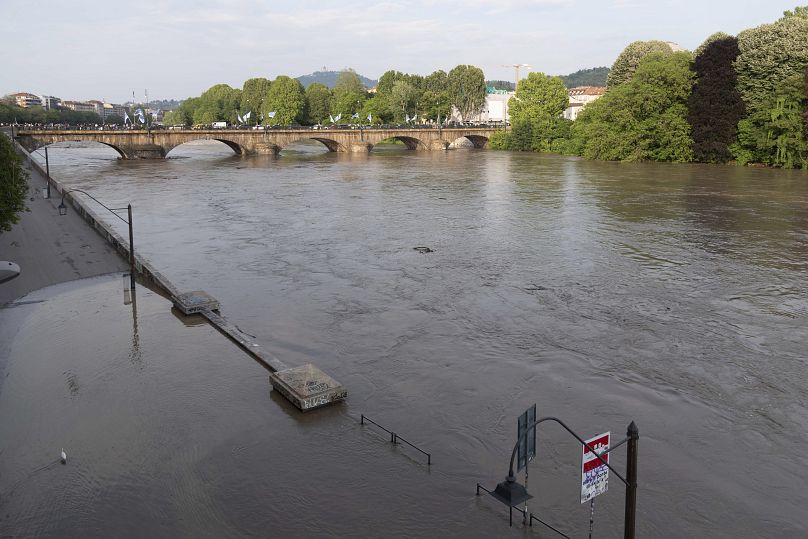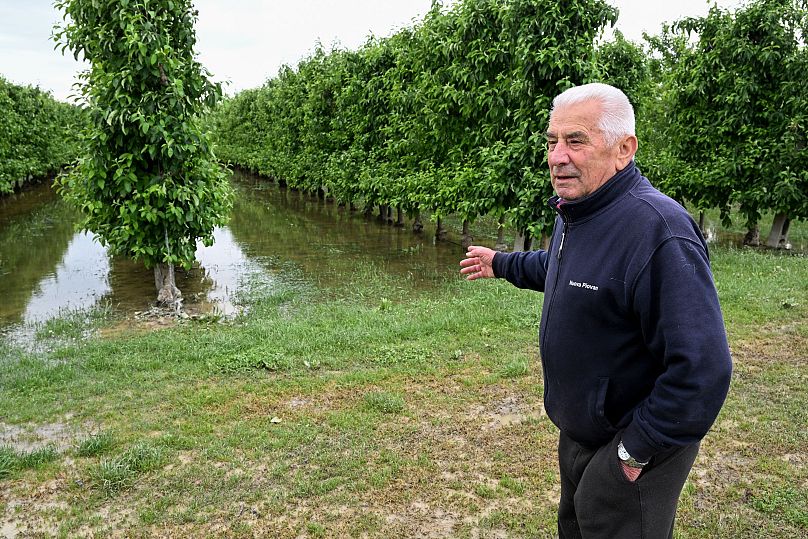Six months’ worth of rain fell in 36 hours resulting in over 300 landslides and submerging fields and roads.
Disastrous flooding in the northern Italian region of Emilia-Romagna has displaced more than 36,000 people and killed 14.
Violent downpours caused rivers to break their banks, filling streets and homes with mud and water.
Six months’ worth of rain fell in 36 hours from 16 May resulting in over 300 landslides and submerging fields and roads.
As authorities and scientists look to the cause of the deadly flooding, a debate has erupted over the role of climate change.
While some researchers and activists say altered weather patterns were key to the devastation, authorities in the region say poor river maintenance was the culprit.
So was human-induced global warming to blame for the floods?
Did climate change cause the flooding in northern Italy?
It is too soon for an attribution study to determine how much more likely, and severe, the Italian floods were made by climate change.
But the science is clear that increased atmospheric concentrations of CO2 are leading to more and more extreme weather events. “Precipitation whiplash” - referring to abrupt shifts between wet and dry extremes - is becoming “increasingly rapid and intense” as the climate warms, according to a new study.
Two years of severe drought in regions like Emilia-Romagna has meant the parched, compacted soil has reduced capacity to absorb water, according to researchers.
“Rising temperatures intensify drought episodes, drying up the soil and changing its permeability in different ways,” says Mauro Rossi, a scientist at the Research Institute for Geo-Hydrological Protection.
Normally, melting snow from the Dolomites Alps and Apennines would furnish a steady flow of water in spring and summer to feed lakes and nourish farmland.
Instead, droughts have created impermeable soil and rain is coming in deluges over a much shorter space of time. This means excessive runoff resulting in rivers bursting their banks.
Italian environmentalists have called out the government’s lack of preparation for situations like this.
Climate change “is affecting territories with increasingly intense extreme events, with risks to people’s lives, and impacts on the environment and the economy,” Italian environmental organisation Legambiente said in a press release. “And Italy once again proves unprepared.”
On Sunday, climate activists in Rome poured black dye into the Trevi Fountain saying the Emilia-Romagna flooding was “a warning.”
Emilia Romagna floods were caused by poor river management
Some experts have cautioned, however, that blaming the climate crisis means overlooking another vital issue.
“If a river bank breaks, it has nothing to do with climate change. It’s a problem of maintenance,” Paride Antolini, president of the Geological Society in Emilia-Romagna, told the Italian press.
Antolini cited problems of reduced staffing in public offices resulting in a lack of river bank monitoring. He also said there was insufficient reforestation in the mountains meaning cascades of water are no longer prevented from flowing into lower lying areas.
“Sometimes there are bureaucratic issues, economic difficulties or perhaps the intervention of some committee, as well as arguments between local councils,” Antolini added.
Plenty of funding has been earmarked for protecting communities from hydrogeological risk, but only a small portion has actually been used.
In 2014, ex-premier Matteo Renzi’s government allocated €8.4 billion to the issue but hardly any of it was put to use before his administration ended. In 2018, the funds were redirected into Italy’s post-pandemic economic Recovery Plan.
“Italy should invest in floodplains and dams rather than the football stadiums. This country throws away opportunities. The money is there and we don’t spend it,” Renzi told the Italian press last week.
Farmers in crisis in Italy’s agricultural heartland
Exacerbated by both climate change and poor maintenance, the floods will have devastating long term effects on a region famed as Italy’s agricultural heartland.
Over 5,000 farms have been submerged by the waters destroying grain, corn and fruit production. Initial estimates have put the damage at €1.5 billion but can only be properly assessed once the waters abate.
The flooding will have damaged plant roots compromising not only this year’s harvest but also those in the next few years.
The damage to the wheat harvest for this year is particularly worrying; at least 400 million kilos of wheat have been destroyed.
Emilia-Romagna is responsible for a third of the national production of wheat so the situation is likely to push up already rising prices of basic products like pasta and bread.
Emilia-Romagna is also known as Italy’s Fruit Valley producing over 10 million tonnes of fruit a year. The agricultural sector as a whole in the region employs more than 65,000 people.
Coldiretti, Italy’s farming lobby, also reported flooded stables and drowned livestock - efforts to rescue animals have been hindered by mud-filled roads.













